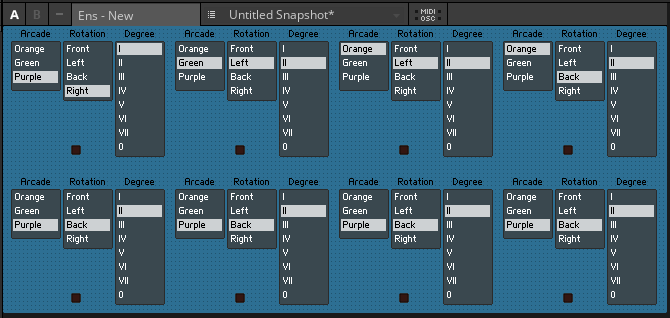The Alpha Cube is, in traditional theory, a minor flat five seventh chord, or three minor thirds stacked up.
There's no more tense chord in the 12 tone system, and moving any one of it's notes becomes a resolution.
#MetaHarmony
I can create chord sequences, do random changes, and then use the same information to pull the notes back into shape.
The second half of each loop changes from constrain to filter, so you can hear what is being done.
The chords generated is the same alpha cube, but the rotations are different, so when constrained to the prism key, resolve differently.
Metaharmony MIDI Encoding Specification
CC85: 2 bits for Arcade, 2 bits for Rotation
CC86: 3 bits for Degree, one bit for any class of binary operations.
CC87: 4 bits denoting Degrees 1,3,5 and 7 of the scale.
sumin' like that.
(edit) 4th bit of CC86 too restrictive.
simultaneous encode and decode of Metaharmony information (It's only 7 bits), is running at about 1.3ms overhead in Bitwig in the Grid now.
I'm using MIDI channel 15 CC 89 for the Prism coordinates (Prism being a projection of the tesseract into 3d space), and CC90 for Degree (Chords I - VII, plus a special Zero-th degree that refers to the Alpha Cube of the local Prism coordinates)
Now how to make that sound like it means anything?
Doing work on #Metaharmony tonight. It's coming along.
Metaharmony is to harmony what a euclidean sequencer is to rhythm.
I've finished the core of metaharmony and basically it's 2^2 + 3^3, or better yet 2^n x 3^m.
My latest metaharmony patch is like thirty modules. Really simple, in other words, and it does everything it should.
I've got it so each note on a standard midi keyboard represents a coordinate in metaharmony space.
There's not many chords that you can't describe with it.
Still working on the grid controller patch, this last session being turning a bunch of calculations into raw numbers to save on processing cycles.
Two rotations of the hypercube (i.e the back of the current projection) gives you a tritone substitution.
Finally making some headway in understanding jazz harmony thanks to #MetaHarmony.
I found out that you can borrow notes from the major scale of the relative minor.
In metaharmony terminology that's a rightward rotation of the hypercube.
Barry Harris' creation theory was a major influence on #Metaharmony.
Here's some jazz guys explaining it.
The four chords are the pillars of the hypercube model.
I'm trying to learn how to describe a very interesting piece of theory to a general audience.
Anyone with any spare neurons available please let me know.
(edit)
This goes under #MetaHarmony and I post from https://musician.social/@ohmrun
#MetaHarmony comes from noticing if you take a diminished seventh chord, *any* movement of any of the notes in any direction by one semitone produces a resolution.
#MetaHarmony is based on the intuition that a twelve tone system gives you three diminished seventh chords which, bound together, produce a cube in four dimensional space: a hypercube.
A #MetaHarmony coordinate has three components.
These are in order:
1) hypercube
2) rotation
3) degree
where degree is the familiar I - VII chord notation.
The first two are there to separate consonance from dissonance in a reliable way.
I've gotten the encoding of #MetaHarmony down to 7 bits, which means it's possible to pass around a metaharmony coordinate in a typical MIDI CC message.
Start of a playable instrument.
I've sorted my #Metaharmony machine. It's got precisely that 4th dimensional weirdness that I'm after.
This is all just applied #Metaharmony plumbed into modulated arpeggiators
